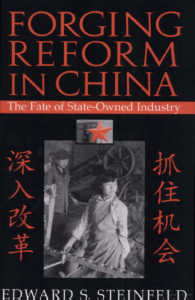By Edward S. Steinfeld
NEW YORK: CAMBRIDGE UNIVERSITY PRESS, 1998
318 PAGES
Reviewed by Penelope B. Prime
 Forging Reform in China by Edward Steinfeld is an ambitious attempt to explain the failure of state sector reform in China. The study is well thought out, deals with a broad range of literature, and utilizes case studies. Because the theory assumes familiarity with economic analysis and some knowledge of the Chinese situation, this book is most appropriate for upper division and graduate courses on transition economies or the Chinese economy.
Forging Reform in China by Edward Steinfeld is an ambitious attempt to explain the failure of state sector reform in China. The study is well thought out, deals with a broad range of literature, and utilizes case studies. Because the theory assumes familiarity with economic analysis and some knowledge of the Chinese situation, this book is most appropriate for upper division and graduate courses on transition economies or the Chinese economy.
Steinfeld argues at length that explanations of problems in transition economies that use a property rights approach are inadequate in the Chinese case. These approaches cannot explain why some firms do well and others do not. In addition, he argues that the issue is not who owns what, but rather the external environment that sets the opportunities and constraints on managerial and government behavior. His alternative approach, which he calls a “nested problems dynamic,” focuses on whether or not decision makers face hard budget constraints with real consequences for poor decisions. The author uses three cases of steel companies, Anshan, Ma’anshan and Shougang, to further illustrate and support his argument.
On the surface, each of these three large state-owned steel companies has been dealt a different hand in the reform process. Anshan is an example of a firm that was given some managerial autonomy and told to pay attention to market demand. Ma’anshan went public in Hong Kong, altering its ownership arrangements substantially. Shougang was taken off the dole completely and given unprecedented freedom to manage its own strategy. While some successes can be found, the outcome of all three cases was spectacular failure to transform themselves into profit-generating, value-creating enterprises. The underlying problem, Steinfeld argues, is that for a myriad of reasons, despite the reform measures the firms do not have to make a profit to survive. The managers continue to focus on output maximization, with access to enough cash to pay their tax obligations. Other obligations can be safely ignored.
While the argument is intriguing and the case research is meticulous, several issues are worth contemplating before throwing out property rights and other frameworks altogether. After reading Forging Reform in China, one wonders how China has made any progress at all. The state sector is in disarray, as Steinfeld carefully and lucidly lays out, and other sectors that seem to be doing better are taxed to support the rest. The result should be inflation or declines in output. In fact, one would think that China should already look like Russia. But unless the facts coming out of China are totally wrong, and unless people really are not better fed as one would guess from casual observation, then something must be going right. This is not to say that serious reforms of China’s state firms are avoidable—they clearly are not. But whether or not collapse is eminent, it appears that China’s gradual, trial-by-error approach has brought substantial progress to date.
The question for China, and for Steinfeld’s analysis, is where to go from here? As the author points out early in the book, while the closing of poorly performing firms is necessary, massive exit from the market is obviously not desirable. The extension of the author’s analysis would be to create the external environment that imposes hard budget constraints on all economic sectors. One concrete suggestion he offers is to begin with the banking sector, making it truly commercial and responsible for lending decisions. This, of course, was the original goal of reforms that shifted budgetary grants to lending via the banking system. It has not worked to date, and it is not clear what would be needed to make it work in the future.
Although Steinfeld argues persuasively that privatization cannot work without broader, systemic changes, the alternative is that government itself reforms the external system, in effect taking its bureaucrats out of the picture. The author himself states that all involved now benefit from the current arrangement, making it unlikely that such change would ever occur. The one hope is that even government officials involved in commercial activity might benefit from a better organized, rationalized market, and hence there will be incentives to move in that direction. This study itself, however, does not leave the reader with such optimism.

